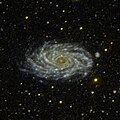NGC 2336
| Galaxy NGC 2336 |
|
|---|---|

|
|
| The spiral galaxy NGC 2336 imaged with the Hubble Space Telescope | |
| AladinLite | |
| Constellation | giraffe |
|
Position equinox : J2000.0 , epoch : J2000.0 |
|
| Right ascension | 07 h 27 m 03.6 s |
| declination | + 80 ° 10 ′ 40 ″ |
| Appearance | |
| Morphological type | SAB (r) bc / RET / Sy2 |
| Brightness (visual) | 10.3 mag |
| Brightness (B-band) | 11.1 NGC 2336 mag |
| Angular expansion | 7.1 ′ × 3.9 ′ |
| Position angle | 178 ° |
| Surface brightness | 13.8 mag / arcmin² |
| Physical data | |
| Affiliation | isolated |
| Redshift | 0.007352 ± 0.000003 |
| Radial velocity | 2204 ± 1 km / s |
|
Stroke distance v rad / H 0 |
(105 ± 8) x 10 6 ly (32.2 ± 2.3) Mpc |
| history | |
| discovery | Ernst Temple |
| Discovery date | 1876 |
| Catalog names | |
| NGC 2336 • UGC 3809 • PGC 21033 • CGCG 348-034 • 349-004 • MCG + 13-06-006 • IRAS 07184 + 8016 • 2MASX J07270405 + 8010410 • 2MASS J07270376 + 8010419 • KPG 132A | |
NGC 2336 is a bar-spiral galaxy with an active nucleus of the Hubble-type SBbc in the constellation Giraffe in the northern sky . It is estimated to be 105 million light years from the Milky Way and about 210,000 light years in diameter. Together with IC 467 , it forms the isolated galaxy pair KPG 132 .
The Type Ia supernova SN 1987L was observed here.
The object was discovered in 1876 by the astronomer Ernst Wilhelm Leberecht Tempel with a 28 cm telescope .
UV recording using GALEX
Image taken with the 24-inch mirror telescope at Mount Lemmon Observatory


